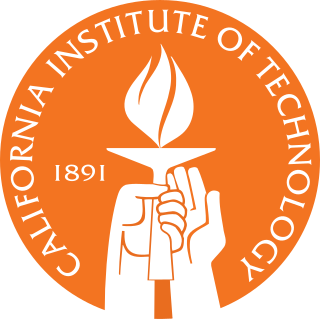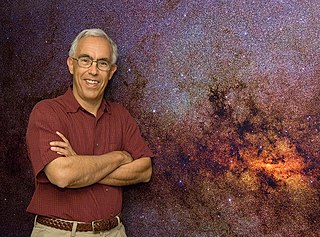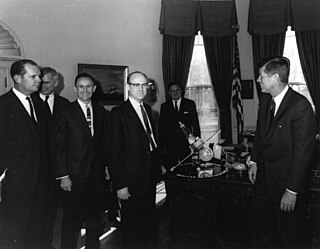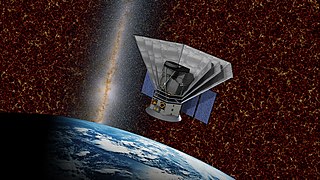
The California Institute of Technology (branded as Caltech) is a private research university in Pasadena, California. The university is responsible for many modern scientific advancements and is among a small group of institutes of technology in the United States which are strongly devoted to the instruction of pure and applied sciences. Due to its history of technological innovation, Caltech has been considered to be one of the world's most prestigious universities.

Jet Propulsion Laboratory (JPL) is a federally funded research and development center in Pasadena, California, United States. Founded in 1936 by Caltech researchers, the laboratory is now owned and sponsored by the National Aeronautics and Space Administration (NASA) and administered and managed by the California Institute of Technology.

The W. M. Keck Observatory is an astronomical observatory with two telescopes at an elevation of 4,145 meters (13,600 ft) near the summit of Mauna Kea in the U.S. state of Hawaii. Both telescopes have 10 m (33 ft) aperture primary mirrors, and when completed in 1993 and 1996 were the largest optical reflecting telescopes in the world. They are currently the 3rd and 4th largest.

The NASA Deep Space Network (DSN) is a worldwide network of American spacecraft communication ground segment facilities, located in the United States (California), Spain (Madrid), and Australia (Canberra), that supports NASA's interplanetary spacecraft missions. It also performs radio and radar astronomy observations for the exploration of the Solar System and the universe, and supports selected Earth-orbiting missions. DSN is part of the NASA Jet Propulsion Laboratory (JPL).

Eleanor Francis "Glo" Helin was an American astronomer. She was principal investigator of the Near-Earth Asteroid Tracking (NEAT) program of NASA's Jet Propulsion Laboratory.

Charles Elachi is a Lebanese-American professor (emeritus) of electrical engineering and planetary science at the California Institute of Technology (Caltech). From 2001 to 2016 he was the 8th director of the Jet Propulsion Laboratory and vice president of Caltech.

Albert Roach Hibbs was an American mathematician and physicist affiliated with the Jet Propulsion Laboratory (JPL). He was known as "The Voice of JPL" due to his gift for explaining advanced science in simple terms. He helped establish JPL's Space Science Division in 1960 and later served as its first chief. He was the systems designer for Explorer 1, the USA's first satellite, and helped establish the framework for exploration of the Solar System through the 1960s. Hibbs qualified as an astronaut in 1967 and was slated to be a crew member of Apollo 25, but he ultimately did not go to the Moon due to the Apollo program ending after the Apollo 17 mission in 1972.

Bruce Churchill Murray was an American planetary scientist. He was a director of the Jet Propulsion Laboratory (JPL) and co-founder of The Planetary Society.

The NASA Exoplanet Science Institute (NExScI) is part of the Infrared Processing and Analysis Center (IPAC) and is on the campus of the California Institute of Technology (Caltech) in Pasadena, CA. NExScI was formerly known as the Michelson Science Center and before that as the Interferometry Science Center. It was renamed NExScI in the Fall of 2008 to reflect NASA's growing interest in the search for planets outside of the Solar System, also known as exoplanets. The executive director of NExScI is Charles A. Beichman.

Laurie Leshin is an American scientist and academic administrator serving as the 10th Director of the NASA Jet Propulsion Laboratory and as Vice President and Bren Professor of Geochemistry and Planetary Science at California Institute of Technology. Leshin's research has focused on geochemistry and space science. Leshin previously served as the 16th president of Worcester Polytechnic Institute.

Dr. Thomas A. Prince is the Ira S. Bowen Professor of Physics at the California Institute of Technology and holds a joint appointment with Caltech’s NASA Jet Propulsion Laboratory (JPL) as a senior research scientist. Between May 2001 and June 2006, Prince was the chief scientist at JPL. He is currently the director and Allen V.C. Davis and Lenabelle Davis Leadership Chair for the W. M. Keck Institute for Space Studies at Caltech.

Robert J. "Bob" Parks was a US aerospace engineer and pioneer in the space program where he was intricately involved and/or directed for some of the most historic and important U.S. unmanned space missions. Over a 40-year tenure at the Jet Propulsion Laboratory (JPL/NASA), located in Pasadena, California, Parks’ impact was essential to helping the United States lead the world in space exploration. He served as Guidance Engineer for Explorer 1, the first successfully launched satellite by the United States. He directed the initial flyby missions to the Moon, the first soft landing on the Moon, Earth's first successful mission to another planet and initial missions to Mars, Saturn, Jupiter and Uranus.

The Asteroid Redirect Mission (ARM), also known as the Asteroid Retrieval and Utilization (ARU) mission and the Asteroid Initiative, was a space mission proposed by NASA in 2013; the mission was later cancelled. The Asteroid Retrieval Robotic Mission (ARRM) spacecraft would rendezvous with a large near-Earth asteroid and use robotic arms with anchoring grippers to retrieve a 4-meter boulder from the asteroid.

Psyche is a NASA space mission launched on October 13, 2023 to explore the origin of planetary cores by orbiting and studying the metallic asteroid 16 Psyche beginning in 2029. NASA's Jet Propulsion Laboratory (JPL) manages the project.

Michael M. Watkins is an American engineer, scientist, and a Professor of Aerospace and Geophysics at the California Institute of Technology (Caltech). He previously served as the 9th director of NASA's Jet Propulsion Laboratory in Pasadena, California, and as a vice president of Caltech, which staffs and manages JPL for NASA. His directorial position was effective from July 1, 2016 to August 20, 2021.

ASTERIA was a miniaturized space telescope technology demonstration and opportunistic science mission to conduct astrophysical measurements using a CubeSat. It was designed in collaboration between the Massachusetts Institute of Technology (MIT) and NASA's Jet Propulsion Laboratory. ASTERIA was the first JPL-built CubeSat to have been successfully operated in space. Originally envisioned as a project for training early career scientists and engineers, ASTERIA's technical goal was to achieve arcsecond-level line-of-sight pointing error and highly stable focal plane temperature control. These technologies are important for precision photometry, i.e., the measurement of stellar brightness over time. Precision photometry, in turn, provides a way to study stellar activity, transiting exoplanets, and other astrophysical phenomena.

SPHEREx is a future near-infrared space observatory that will perform an all-sky survey to measure the near-infrared spectra of approximately 450 million galaxies. In February 2019, SPHEREx was selected by NASA for its next Medium-Class Explorers mission, beating out two competing mission concepts: Arcus and FINESSE. As of August 2022, SPHEREx is targeted to launch no earlier than April 2025 on a Falcon 9 launch vehicle from Vandenberg Space Force Base. The principal investigator is James Bock at California Institute of Technology (Caltech) in Pasadena, California.

Edward Seymour Forman was an American engineer and inventor known for his pioneering work in early rocketry in the United States. Forman, along with his collaborators in Guggenheim Aeronautical Laboratory at the California Institute of Technology (GALCIT), demonstrated the first practical jet-assisted take-off (JATO) of an aircraft in the United States. Forman was among the GALCIT innovators that went on to found Aerojet General Corporation, the largest rocket technology manufacturer in the 1940s, and the GALCIT Rocket Research Group itself became the precursor of the Jet Propulsion Laboratory.

Anne L. Kinney is an American space scientist and educator. Kinney is currently the Deputy Center Director at NASA Goddard Space Flight Center. Previously, she held positions as the head of the Directorate for Mathematical and Physical Sciences (MPS) for the National Science Foundation (NSF), the Chief Scientist of the W.M. Keck Observatory, Director of the Solar System Exploration Division at NASA Goddard Space Flight Center, Director of the Origins Program at NASA Jet Propulsion Laboratory, and Director of the Universe Division at NASA Headquarters. She earned a bachelor's degree in astronomy and physics from the University of Wisconsin-Madison and a doctorate in astrophysics from New York University, and has published more than 80 papers on extragalactic astronomy. She was an instrument scientist for the Faint Object Spectrograph that flew on the Hubble Space Telescope.
Lunar Trailblazer is a planned small lunar orbiter, part of NASA's SIMPLEx program, that will detect and map water on the lunar surface to determine how its form, abundance, and location relate to geology. Its mission is to aid in the understanding of lunar water and the Moon's water cycle. Lunar Trailblazer is currently slated to launch in early 2024 as a secondary payload on the IM-2 mission. The Principal Investigator (PI) of the mission is Bethany Ehlmann, a professor at Caltech.



















